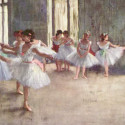Artists know how to create momentum in at least two ways. First, there is a sense of movement in nearly every work of art, whether visual, aural, physical, or a combination.
![Ballet Rehearsal, Edgar Degas, 1873 [Public domain], via Wikimedia Commons Ballet Rehearsal, Edgar Degas, 1873 [Public domain], via Wikimedia Commons](https://artsawareness.com/wp-content/uploads/2015/01/Edgar_Germain_Hilaire_Degas_004web.jpg)
Our eyes and ears, and at times even our bodies, sense the momentum created by the artist who guides us through an experience in time and/or space. We may not even be consciously aware of the affective movement; just that it results in an impression and overall feeling. While artists create motion in their works to hold our interest and help us see and hear, they also know how to create, build, and maintain momentum in their artistic lives. They make a commitment and are willing to make small and large changes in their approach and work that leads to and builds momentum. They understand that momentum doesn’t go on and on uninhibited by obstacles and adversity. When stopped or slowed, they create a new way forward and continue until the cycle is complete or a new obstacle presents itself. The phase continues, and their skill improves with each new beginning.
The world is wide, and I will not waste my life in friction
when it could be turned into momentum.
~ Frances Willard
Here are some ways artists use the materials of their art form to create momentum in their works.
![Yellow-Red-Blue, Wassily Kandinsky, 1925 [Public domain], via Wikimedia Commons Yellow-Red-Blue, Wassily Kandinsky, 1925 [Public domain], via Wikimedia Commons](https://artsawareness.com/wp-content/uploads/2015/01/Vassily_Kandinsky_1925_-_Jaune_Rouge_Bleu_Yellow_Red_Blue-300x250.jpg)
[sws_checklist]
- Edgar Degas used the natural sense of body movement to give us a feeling of momentum. In the painting above, he implied movement by positioning the dancers so that we feel the physical movement in the work.
- Baroque music uses long phrases, few pauses, rhythmic complexity, and sequences to build momentum. Listen to the way Bach’s driving rhythms, regular patterns, steady pulse, and rapid passage work in all parts contribute to the overall momentum and affect in the first movement of his Brandenburg Concerto No. 1 in F Major.
- Wassily Kandinsky used repetition, placement of objects, as well as directional, diagonal, and gestural lines to give us an illusion of motion. The painting shown here shows the strong sense of movement in his abstract work.
[/sws_checklist]
Commitment is an act, not a word.
~ Jean-Paul Sartre
In today’s complex life and work environments, understanding momentum is critical to our success. We can gain a lot by studying the artistic process, both in terms of the use of the materials of our lives as artists do in their art form, as well as in the discipline and creative practice itself. Momentum comes from disciplined commitment, the consistent willpower to keep showing up. And when you experience momentum, you need to keep at it, flowing with the forward motion all the way until it reaches a natural ending. And then you start again. When artists create, they shut out distractions and make a full commitment to their work. Creating momentum requires the kind of focused commitment that allows you to use your full capacity. Artists can’t survive in their creative work without that kind of discipline.
Here are some ways you can use the discipline of an artist to move forward in your life and work situations.
[sws_checklist]
- Focus your energy on creating rather than thinking about what you want to create. That activity creates energy and will produce momentum.
- Move on when the momentum produces results or ends.
- The discipline needed to create momentum is all-encompassing. It requires a comprehensive and complete effort.
[/sws_checklist]
As Zig Ziglar said, “It was character that got us out of bed, commitment that moved us into action, and discipline that enabled us to follow through.” Make building momentum a priority and create great art.
— Pat
Sign-up for the Arts Awareness eNewsletter and receive a free gift “Three Lessons to Begin to Make Artistic Principles Work for You in Fascinating Ways.” Like Arts Awareness on facebook.
